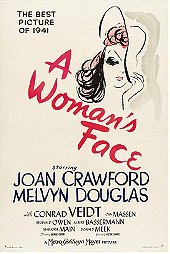Joan Crawford was a movie star who radiated a sense of authority, she was more overtly masculine than most of her male co-stars. Hers was an indomitable will and personality that was not going to back off for anyone or anything. And there was always the barely concealed rage. She was often a frothing, rabid uncaged animal that was ready to pounce on the first object to come into its line of vision. And it seems so obvious that much of this was a mask for a neediness and vulnerability. She was bound and determined to be loved, adored and to succeed, at any and all costs.
A Woman’s Face externalizes her interior wounds and psychological scars in a horrible disfigurement on the right side of her face. And George Cukor effectively reigns her in, makes her frequently drop the glamorous suffering and movie star posturing that marked much of her work. What we are left with is a performance that’s vulnerable and gives a context to her desperate neediness, rage and overtly masculine compensation tics. (Until she gets her face restored, and some of Crawford’s melodramatic tics come roaring right back.)
The first half of A Woman’s Face is, by a wide margin, the more successful film. The second half feels like a totally separate film with the flimsiest of connective tissue between them. In the first half, Crawford plays a woman who has allowed her disfigurement to turn her self-worth into a wilting flower. And it’s this sense of wilting and rotting in her that causes her to take that anger out on the world. Because of the gaping emotional wounds inside of her psyche, she has become a blackmailer and a criminal. Her slanted hat or a cascade of ebony hair to hide her scar proves to be her armor.
In the second half, Melvyn Douglas plays the plastic surgeon who fixes her face, restoring her beauty and wondering what he has unleashed. Now that her face has been cured, so has all of the rot and rabid animal ferocity within her character as well? She awakens from her makeover deciding that she’s now a good person and wants a fresh start as a governess. The problem here isn’t that her character wants to remake her life, that’s a given, it’s that the anger is no longer there. It’s during this section that Cukor loses some of his stranglehold on Crawford’s performance and she indulges in her worst mannerisms and lazy shorthand.
In small doses, like when Conrad Veidt, playing his character like a poisonous snake slowly toying with Crawford before going in for the kill, tries to get her to murder the child she’s in charge of, she unleashes. But there’s never a moment when we’re satisfactorily told or allowed to enter into her emotional terrain. She’s finally been granted a chance to look normal, and how does this new physical appearance affect her psychologically? Does she recognize herself?
But it’s still mostly successful as an examination of one of Cukor’s favorite themes: the exterior and interior coming into direct conflict. The first half is a must-see, and one wishes that they had followed through with that film’s promise. The second half is just a well-made melodramatic Crawford star vehicle. And extra praise should be given to Cukor for wringing such a nuanced and melancholic performance out of Crawford, truly this is one of her best. Possibly even better than what her fans consider her holy trinity -- Mildred Pierce, Possessed and Humoresque.
 Login
Login